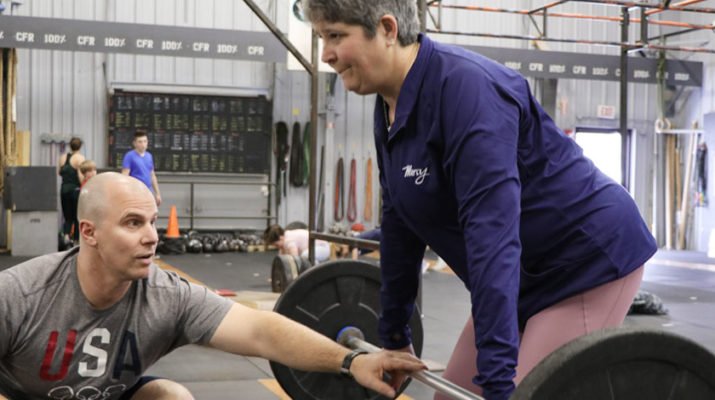By Deborah Jeanne Sergeant
If you don’t do high-intensity functional training (HIFT) such as at CrossFit, you likely know someone who does. HIFT workouts have become very popular. Flipping over tractor tires, hauling cement blocks and jumping on top of a stack of wooden blocks is far different from exercise regimens like spinning and running — and that’s the point.
HIFT-style classes offer high intensity functional training that constantly change and challenge every area of the body and aspect of fitness: strength, endurance, balance and flexibility. They’re also designed to create camaraderie. Instead of slogging solo on bikes or plodding side by side on treadmills, HIFT classes encourage a teamwork environment as members of the gym cheer and encourage each other to complete the same workout with a few modifications as needed.
Anecdotal reports of injury and even a few lawsuits have tarnished the reputation of CrossFit and other HIFT-style classes.
In late 2018, a study published in the Orthopaedic Journal of Sports Medicine looked at injury rates of participants in HIFT (specifically CrossFit, as it’s the most popular and identifiable HIFT class). The study surveyed 3,049 CrossFit participants between 2013 and 2017.
More than 30% reported injury because of CrossFit in the past 12 months, including shoulders (39%), back (36%), knees (15%), elbows (12%) and wrists (11%). That meant an injury rate of 0.27% per 1,000 hours of participation. The study concluded that CrossFit “is relatively safe compared with more traditional training modalities.”
But the caveat is that those new to CrossFit (less than a year) and who train fewer than three workouts weekly are at greater risk, which may indicate that their lack of fitness and conditioning contributed to their likelihood of injury.
“A lot of physical therapists and chiropractors see people with CrossFit injury,” said Dennis Lesniak, doctor of chiropractic. He has a master’s in clinical nutrition and bachelor’s in exercise science. He works at Quarter Deck Athletics-CrossFit QDA in Buffalo.
He thinks that the high participation rate skews the statistics. For example, someone who plays tennis three times a month doesn’t participate as often as someone who trains at CrossFit five or six days a week.
Lesniak also said that some people may attribute their injury to “CrossFit” who are mimicking a Workout of Day (WOD) at home. CrossFit gyms post their WOD online, but at home, there’s no coach to guide them in how to perform movements safely.
Also, the gym offers scaling options for people who have limitations.
“That may not be on the website,” Lesniak said. “If someone said, ‘Let’s play football’ it’s not going to be the Super Bowl. What you see online isn’t what 99.9% of the CrossFit population is doing.”
He also added that “every exercise program has some degree of risk.”
Especially for those who are out of shape, Lesniak encourages consulting with a health care provider and proceeding under the guidance of a trained professional to ensure gradual progress in intensity, appropriate warm-up and stretching and that each movement is performed safely.
“Most CrossFit gyms have an introductory process, like an on-ramp class or one-on-one,” Lesniak said. “It’s a way to screen participants. The challenge comes when people want to move faster or move heavier weights. We have to help them keep their egos in check.”
Knowledge of each client is key to safe and effective workouts. That’s why careful screening and making expectations clear is vital.
“We talk about very clear communication,” Lesniak said. “We talk about soreness from exercise or pain. I don’t care if you’re sore. Sore is fine. I care if you’re in pain. If the athlete doesn’t feel right, we scale the movement so they’re not in pain. “
He encourages people to make sure they know their own capabilities and that they don’t push past that point and allow injury.
“Everybody and every exercise is so complex and different,” said Laura M. Anderson, Ph.D., assistant professor and licensed psychologist and director of the PULSE Healthy Weight Research Team at University at Buffalo. “Always consult with your healthcare team whether your doctor, personal trainer, and others. Even if it’s walking, you may need to talk with your healthcare team.”
She said that selecting a form of exercise that’s sustainable for the long run is important for increasing the chances of maintaining good health.
“Make sure you enjoy it, have access to it and you’re willing to put these together,” Anderson said.
She views camaraderie as a factor that can help some people stick with an activity, but it can also push some participants toward injury.
“Knowing your own limits is so key,” Anderson said. “Listen to your body instead of the peer pressure. That’s the double-edged sword of the peer environment. Don’t push too far.”
She also said it’s important to keep in mind a back-up activity in case something happens to prevent participation in the favored activity.
The practice of Kim Fenter, doctor of naturopathic medicine at Audubon Women’s Medical Associates, P.C. in Williamsville, is geared toward nutrition, weight loss and healthful lifestyle.
“I ask my clients to exercise but in most cases the exercise choice is based on a client by client health history and their current level of activity,” she said. “My client’s likes or dislikes have a lot to do with the sustainability of an active lifestyle. If you have someone who doesn’t like going to the gym and enrolling in classes, the likelihood of their sustainable active lifestyle or success is compromised from the start.”

